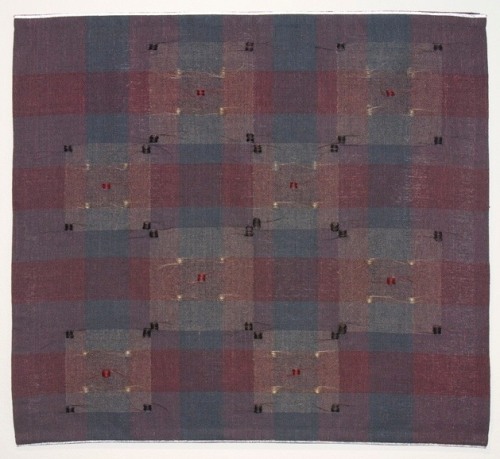
Trine Ellitsgaard
A Latin American Master Who Happens to be Danish
To be of a place and at the same time apart from it is perhaps to see its beauty, and its ironies, with more clarity. Trine Ellitsgaard grew up in Denmark, and it was there she trained as a weaver, but for the last twenty years she has lived in Oaxaca, Mexico. Stepping outside the serenity of her studio, you are instantly confronted by the wild cataclysm that constitutes daily life in Latin America—the clashing aromas of flowers and exhaust, the sounds of birdsong and jackhammers, the saturated colors of sky, colonial buildings, and graffiti—all woven into a rich, anarchic texture that threatens at every moment to overload the senses. You cannot help but be swept into the chaos, or fight against it, or both.
It is more than an interesting side note that Trine still weaves on the loom she imported from Copenhagen when she first arrived in Mexico. Looking at her textiles, what is most striking is not the overtly visible influence of Oaxacan craft but its apparent absence. The ordered geometric designs, the muted colors, the soothing balance of forms and textures all seem to express a Scandinavian sensibility in direct contrast to a life spent in Mexico or to traditional Mexican weaving.
But the influence is undeniably there.
Sometimes it is in a form she has appropriated, such as the woolen skirt worn by the Chomulas of Chiapas—Trine has joined two woolen lengths with a luminescent ray of reflex threads. Or it might be in an element suggested by ritual: the dried flowers set upon the graves in the town of San Antonino during Day of the Dead become paper pom poms in an homage to her father.
In another collaborative piece, a group of women palm weavers in the Mixteca region of Oaxaca have created a long palm braid that Trine has woven into an open structure and joined with threads of red horsehair. Most often, however, the experience of Mexico is found in the combinations of the materials themselves. Gold thread and plastic, paper and silk, sisal and seeds—the organic is paired with inorganic, luxurious with pedestrian, rough with smooth, shiny with sensual. Underneath the deceptive simplicity and harmony of the designs, these surprising clashes and combinations reveal a delight in strangeness as well as the peculiar beauty that can emerge from chaos. Trine’s work takes hold of all that she has observed in Mexico, but the Scandinavian in her reconstitutes it into new patterns; out of the meeting of these two cultures emerges a new way of seeing both.
Michael Sledge
September, 2010
(Michael Sledge is an author and also the co-founder of Oax-i-fornia, an art studio in Oaxaca, Mexico, which unites local artists with students from California College of Arts in San Francisco)
Mr. Sledge’s most recent novel is the highly acclaimed, “The More I Owe You”, an intimate portrait of poet Elizabeth Bishop.